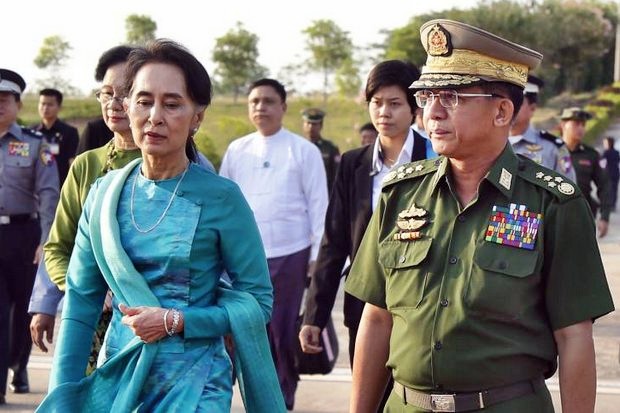
The violent fallout from Myanmar’s military coup threatens to erupt into a regional crisis, amid warnings of “state collapse” and a pending “civil war” if left unchecked.
The Southeast Asian nation is deadlocked two months after the military’s 1 February takeover. A widespread protest movement has shut down Myanmar’s economy, and security forces have responded with deadly violence that has killed more than 550 people as of 1 April, according to local rights monitors.
At least two of the country’s major ethnic armed groups have pushed back against the military, and others have warned they could get involved. Fresh clashes in remote conflict zones – including military airstrikes in southeast Myanmar – have forced thousands to flee.
The crisis is beginning to spill into neighbouring Thailand and India as civilians and defecting security forces attempt to find safety, sparking warnings that a refugee crisis could quickly spiral.
“The crisis is set to deepen, with the prospects of greater bloodshed, economic damage, humanitarian emergency, and refugee flight to neighbouring countries growing,” the International Crisis Group said in a briefing.
The UN’s top envoy for Myanmar, Christine Schraner Burgener, this week warned of “the possibility of civil war at an unprecedented scale”.
Here’s a snapshot of the latest humanitarian implications of the coup:
India, Malaysia, and Thailand: Flight and pushbacks
The coup’s humanitarian fallout is pushing beyond Myanmar’s borders.
The UN’s refugee agency, UNHCR, this week urged neighbouring countries to offer protection to “anyone crossing the border, seeking asylum in another country.”
In late March, nearly 3,000 civilians fled the border regions of Myanmar’s Karen State, attempting to take refuge in neighbouring Thailand, according to the Karen Women’s Organization. Rights groups said most of the refugees were forced back; Thai authorities said they “voluntarily crossed back”.
At least 91,000 people already live in refugee camps in Thailand, having fled decades-long unrest in the border area.
The civilians were fleeing airstrikes and military bombardments that also forced 10,000 people to hide in forests near their villages, local groups said.
On the other side of the country, hundreds of people from Chin State have fled to India’s northeast border, including Mizoram State, where there are strong cross-border ties among communities on both sides.
Other areas have been less welcoming. One state, Manipur, reportedly ordered incoming refugees to be “politely turned away”, before officials backtracked this week. Earlier in the month, India’s home affairs ministry warned officials in northeastern border states of an “illegal influx from Myanmar,” The Times of India reported.
The UN’s human rights office urged countries not to “forcibly return” refugees and migrants. In February, Malaysian authorities deported at least 1,000 people to Myanmar despite a court order. There are some 180,000 registered refugees and asylum seekers in Malaysia, along with tens of thousands more without papers.
Maritime borders have hardened as well. A ship carrying dozens of Rohingya refugees left Bangladesh in February and is still stranded. A UNHCR spokesperson told The New Humanitarian: “Recognising the hazards at sea, coupled with the fact that there are no experienced crew members on board, we remain deeply concerned.”
In Myanmar: Old conflicts and new displacement
The coup has injected new volatility into Myanmar’s multiple unresolved conflicts, upending fragile ceasefires and sparking renewed clashes.
Two of the country’s largest ethnic armed groups – the Kachin Independence Army in the north, and the Karen National Liberation Army in the southeast – have launched offensives against the military
Several hundred people were displaced in Kachin State, local rights groups and the UN said, in what were the first major clashes since 2018.
The Karen National Union – the political head of the KNLA – has condemned the coup and vowed to protect protesters in its southeast territory.
Other major armed groups have also issued warnings in recent days, including Rakhine State’s Arakan Army, which had been at the centre of one of the country’s fiercest conflicts with the military before an uneasy ceasefire in late 2020.
This week, the Arakan Army and two allies issued a statement promising “to support and cooperate with our oppressed brethren and multi-ethnic people” if the military did not stop “killing innocent civilians”.
The Arakan Army had been relatively quiet. Earlier, the armed group had urged Rakhine civil society groups not to encourage anti-coup protests in Rakhine State, a local aid worker told The New Humanitarian in March. The Arakan Army “said that they are building trust with Myanmar’s military,” the aid worker said.
It’s unclear how realistic it would be for Myanmar’s myriad armed groups to work together; some have waged war with the military – but also each other – over decades.
Politicians ousted in the coup are also floating plans for a “federal army”. The de facto government-in-exile, known as the Committee Representing Pyidaungsu Hluttaw (CRPH), announced it had rescinded a 2008 constitution that had cemented the Myanmar military’s grip on government affairs, and had drafted an interim “federal democracy charter”.
The international response: Sanctions but little consensus
Attempts to resolve the crisis from outside have led to layers of new sanctions from mainly Western countries, but little consensus.
Some protesters in Myanmar have called for a military intervention, invoking Responsibility to Protect or R2P – the UN-recognised doctrine that obliges countries to prevent genocide, crimes against humanity, and other atrocity crimes.
Many of the doctrine’s proponents say an armed intervention is extremely unlikely and ill-advised. They point out that R2P includes a wide range of options, including diplomatic levers through the Security Council.
The CRPH is calling for a range of measures, including a global arms embargo on Myanmar’s military, for the Security Council to refer Myanmar to the International Criminal Court, and for council members to consider “whether there is a responsibility to protect”.
There was little outward progress after a closed-door Security Council meeting on 31 March, however. A statement following the meeting expressed ”deep concern at the rapidly deteriorating situation”.


